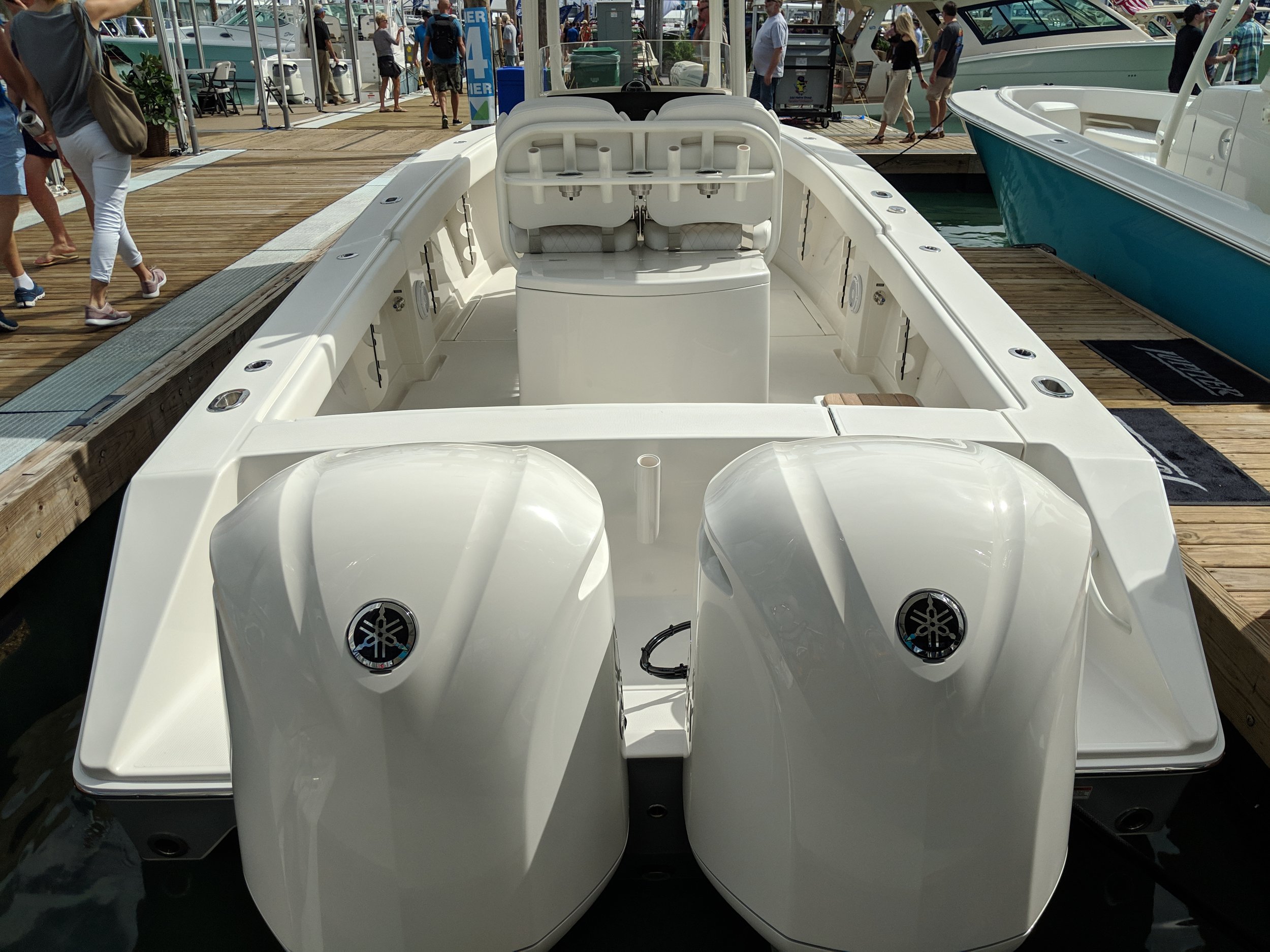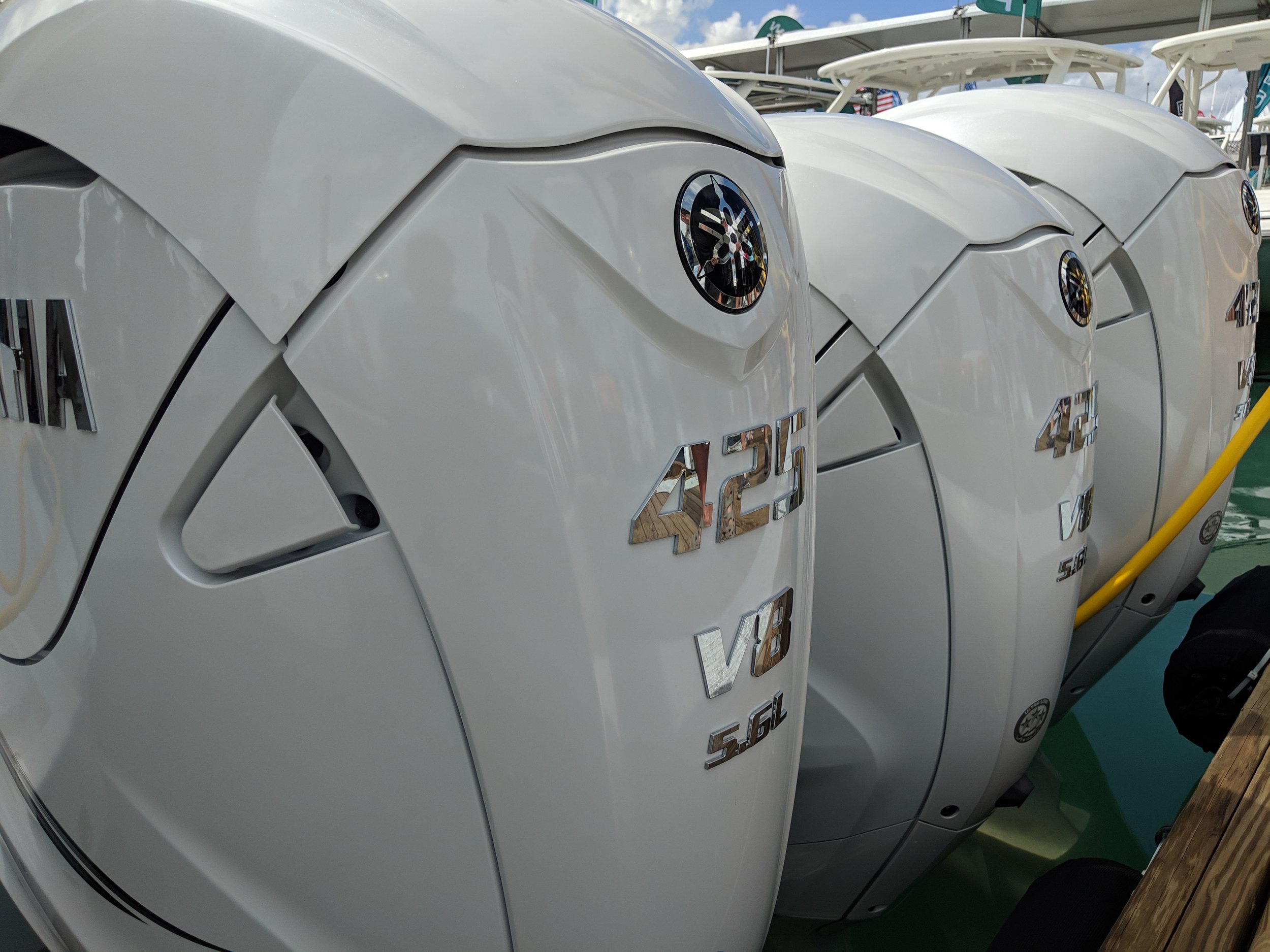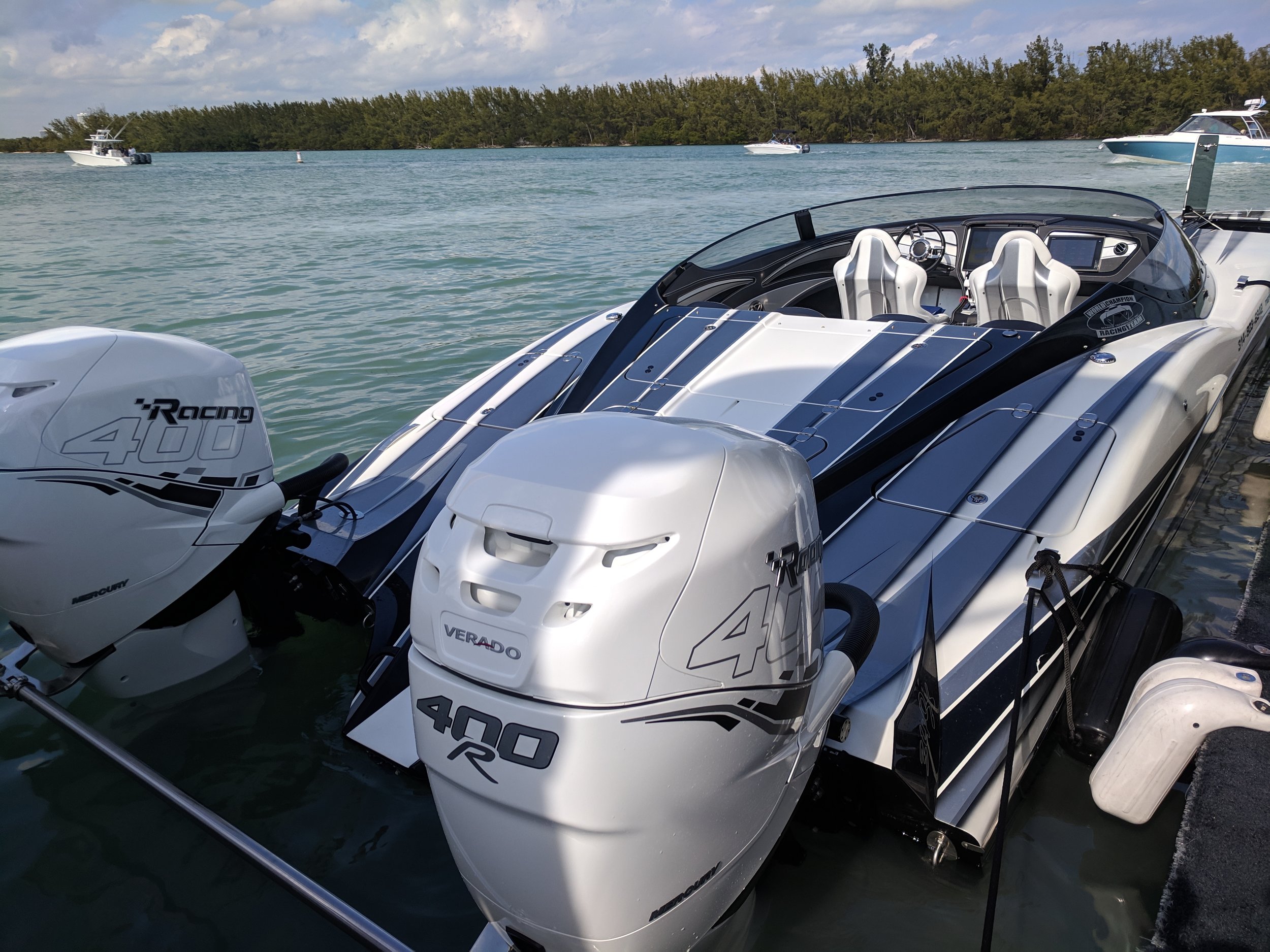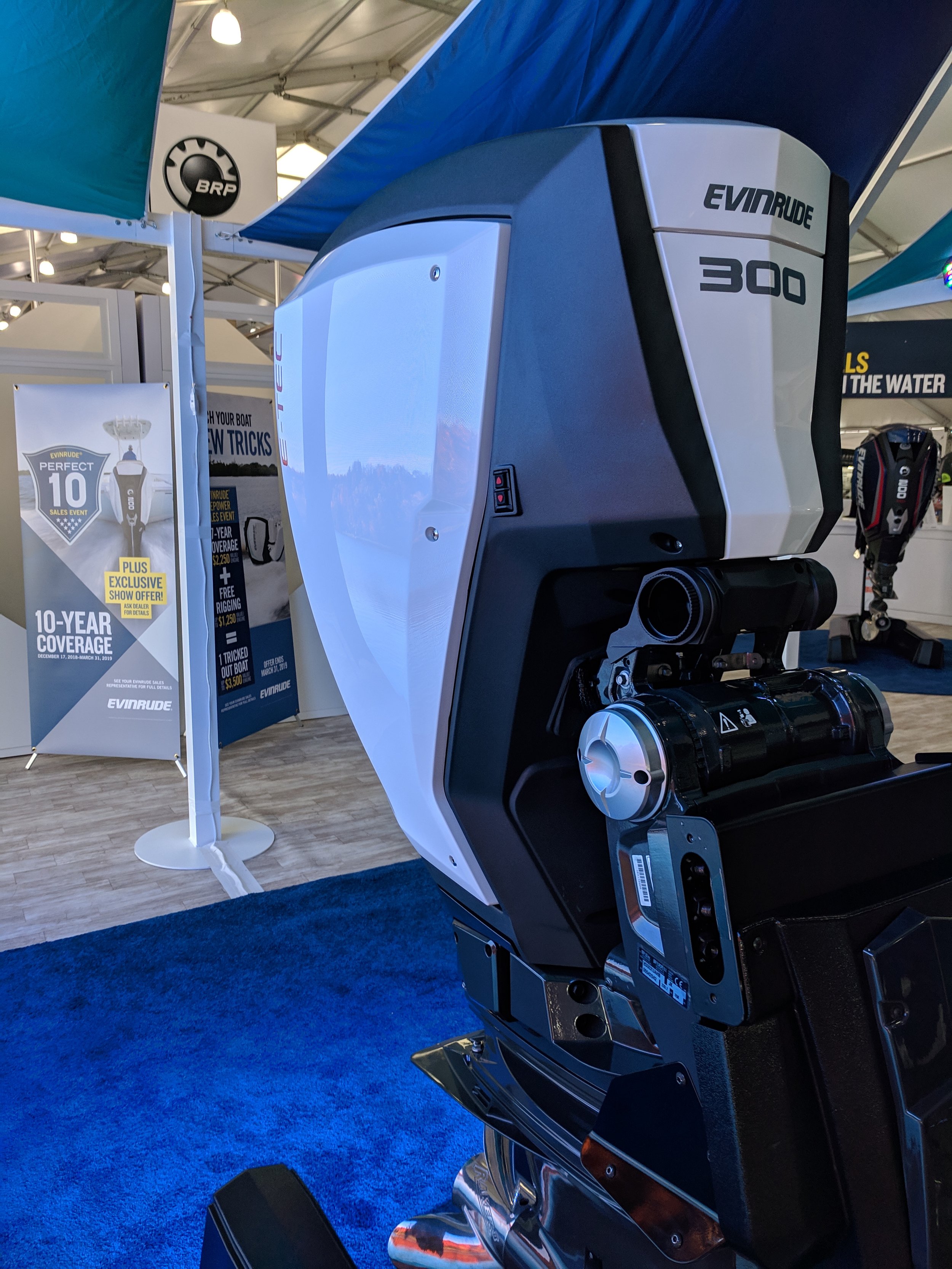The Most Powerful Outboards: The Biggest Engines from Mercury, Yamaha, Seven, Suzuki and Evinrude
After getting back from the Miami boat show, my initial reaction is to write a bunch of articles and talk about the the show, and I did do that to an extent. But, what I really enjoy is looking back and absorbing what I saw, going through the interviews, and photos, then doing a deep dive into what is happening in the industry. Also, I love to predict what we will see next from the engine builders. This year, wasn’t necessarily the year of new engines like previous years, but there were plenty of new models, updates and hints at what is coming next. Let’s take a look at each manufacturer, see what they showed in Miami, and what they were talking about for the future. This will mostly focus on the V8 engines and 300 HP and up models.
Most of the V8 engines on the market are for heavy duty offshore center consoles, or cruisers, with only Mercury making anything truly high performance in the 350+ HP range. But, it is still interesting to see what is going on in the industry.
Suzuki Marine
A company that you have to admire, and has pretty much curb stomped rival Honda Marine into oblivion. Well designed outboards, priced right, aimed at the re-power market. And, Suzuki has a large OE supplier network, very impressive for a company that was not in this position just 10 years ago. Their outboards look amazing, the engines are reliable and have tons of features found on more expensive outboards. The popularity of the DF300, no doubt inspired the large DF350. Instead of incorporating Suzuki’s unique selective rotation gearcase, they went ahead and incorporated the dual counter rotating prop idea common in sterndrives from MerCruiser, Volvo and Ilmor. For low end slip, tracking, and thrust at low speed, dual props are hard to beat. And for the market Suzuki is going after, it was a great strategic play, it’s an absolute differentiating feature in a sea of sameness.
No other manufacturer offers a dual counter rotating prop configuration in the 300 to 400 HP Range. Perfect for heavy boats, or single engine applications.
Aesthetics are often overlooked, but Suzuki offers most of their engines in black and white, and the look very modern. The DF350 is a 4.4 liter V6, DOHC 24 valve engine. It has sensors to optimize efficiency, comes in 25”, and 30” shaft length and weighs in at a reasonable 727 Lbs. Reasonable being relative, compared to the other 350+ HP engines. The gear ratio is 2.29:1, which is insanely low. Suzuki’s rationale, not mine, is that larger diameter props reduce slip, and higher pitch propellers have less slip as well. Of course, that’s only partially true, but when applied to heavy, low performance boats, you can make the case for lower gears. Higher pitch props can have less efficiency though, and when you have a more efficient hull, you would want taller gears, and optimize the prop. But that’s a whole other story.
Suzuki offers a clean aesthetic, and a great value. The DF350 is a great single engine option when you need serious torque, and the benefit of the dual propellers. More economical than twin 200 HP engines.
The DF 350 is for heavy boats, running twins instead of triples, or a single instead of twins, and are efficient at lower speed cruising. I like it, if you’re re-powering an old center console with twin 200 outboards, you’d be further ahead in some cases with a single like the Suzuki DF350. Paring down multiple engines can save weight, drag, and cost.
Yamaha
You have to admire Yamaha as a company. People who buy Yamaha outboards are very similar to people who drive Toyota cars, and are the type of people who get up at 5:00 am, exercise, read a book, and fix the garden before going to work. They get more done before 8:00 AM than the entire state of Colorado gets done in a month. You’d be happy to have them as a neighbor, smile and wave when you see them, but you secretly hate these people. I do too. But let’s talk about their big outboards.
The 5.3 F350C Yamaha is a very popular engine. A powerful and well priced offering. A big displacement cruiser for heavy boats and large multiple engine center consoles.
Yamaha were pioneers when it came to gigantic outboards with the big 5.3L 350 HP outboard back in 2007. Of course, the OMC V8’s were the real pioneer of V8 outboards, but for modern outboards, Yamaha was ahead of the curve here. The original 5.3 was heavy, based on a new platform, that didn’t share parts with the V6. The behemoth, weighed over 800 Lbs, but had unbelievable low end torque. It was also priced really well, only about $5k more than a 250 V6, it was a well suited to the new crop of giant center consoles and dual console boats. The latest iteration, the F350C, is just a refined version, and the 5.3 inspired the new 5.6 Liter 425 XTO.
Packed with features, and big power, for larger 40’ plus size boats. Electric integrated steering, DFI technology, fly by wire features, and a massive gearcase make this a very compelling option for the big boys.
For the 425 XTO, Yamaha used the same logic as the F350, suit if for big offshore fishing boats and cruisers. Make it a naturally aspirated, large displacement engine, that can loaf all day, and is packed with new features. Yamaha used automotive style direct injection technology to achieve as much efficiency as possible. A massive gearcase that can fit 17 ⅛” diameter props, dual overhead camshafts that feature a unique self tensioning chain, and an integrated fully electric steering system, illustrate some of the new technology Yamaha is using.
The steering of the 425 XTO Offshore is the biggest achievement for Yamaha. A fully electric powered steering ram, connects to a Y shaped mount. Not only do you forgo the hydraulic lines, but the steering input is precise, can sync to multiple engines, and has very little maintenance. Electric steering is really where things are going. Everything is fly by wire.
I’d rather run a single than twins. Not a bad use for it here.
For large, and I mean 40 foot plus offshore boats, this is a really amazing engine. Offered in 25, 30, and 35” shafts, the beast revs to 6,000 RPM, and has a really high compression of 12.2:1. The weight is not crazy when you think of the steering being integrated, but it’s not light at 952 Lbs. One thing Yamaha gets right in most of their lineup is the gear ratio, the 425 XTO features 1.79 gears. You could run it as a single on a good sized hull, but it was really designed to run on the big boats with multiple engines.
Mercury Marine and Mercury Racing
Mercury went all in on the 4.6L V8 platform. The V6 lineup was new at the 2018 Miami show, and it was a full departure, large displacement, mechanical and electric controls, but with no frills. For the V8, it was the same recipe. The only thing Mercury did that was surprising was offer the ProXs version in a V8 all the way down to 200 HP. This kind of goes against the light weight logic of the new platform, making the 200 ProXS one of the heavier 200 HP engines on the market. But the V6 200 is one of the lighter ones, it doesn’t make sense to me, and just makes the lineup more confusing.
The bigger news was the V8 platform for Mercury Racing. The 300R is a winner in every way. You can configure it in many versions too, a HD version gets an offshore style remote trim system, there are three gearcase options: HD 5.44, torque master, and the sport master all in 1.75 ratios. As of April 2019, Mercury Racing is also offering an optional 1.60:1 ratio in the 300R. Solid mounts, and mechanical or DTS controls mean the 300R is versatile, and impossible to beat in the 300 HP range if you are running a performance hull. This is where Mercury Racing separates itself, no other manufacturer offers solid mounts and a high performance gearcase. Since the Racing 300 is so well tuned, it actually outperforms any other 300 HP outboard by a wide margin, and even gives it’s big brother the 400R a run for the money. I’d rather have a 300R all day, it’s a way better engine.
A custom painted set of triple Mercury Racing 300Rs. in the 300 to 350 HP range, nothing can perform like these. You see them on everything from sport cats, to big center consoles. Versatile and excellent power to weight, plus can be configured multiple ways.
The 400R from Mercury Racing is the champion though in the 350+ range for anything either high performance or semi performance. It just has the options you need, different gearcases, and big power. The popular 400R has excellent power to weight, and offers better value in this category than anything else. It’s best for sport cats, performance center consoles, big single engine performance boats.
The go to for most sport cats, the venerable 400R is hard to beat on anything from a tunnel, to a performance center console. Power to weight is superior to anything else.
The new V8 Verado only goes up to 300 HP, and the big announcement in Miami was a toned down version of the Mercury Racing 2.6L 400R, into a 400 HP Verado. What’s missing? No solid mounts, no sport master, revs a little lower, and tuned for slightly less power, still a class leading engine in this range though. The 350 HP Verado is really popular, it fits so nicely in the twin engine sport center console market. In fact, as much as I dislike the 2.6L supercharged Verados, the 350 and now the 400 HP, are hard to beat for power to weight. Count on Mercury coming out with a larger displacement naturally aspirated replacement for the old 2.6L Verados to retire the 350 and 400 at some point.
The silent and clean looking Mercury Verado and regular V8 300 outboards are hard to beat for value. Torque is massive, and I prefer the naturally aspirated V8s to the 2.6L supercharged Verados.
Of course, Mercury offers 3 other versions of the 4.6L V8 in the 300 HP range. The Sea Pro 300, ProXS, and the regular 300 HP. All are virtually the same with slight variations. Will Mercury make something greater than 400 HP? Most likely. Will Mercury Racing? Most likely. We will have to wait until the 2020 Miami Boat Show though to learn more though.
Seven Marine
Seven basically updated their lineup, offering a new 527 HP model that comes down in price, and offers the standard twin pinion gearcase (1.19:1), as well as the new CR, which is a counter rotating dual prop model, inspired by parent company Volvo’s success with counter rotating dual prop configurations. The 577S again, is based on the GM all aluminum supercharged V8. Superior power over anything else on the market, add the optional GT performance gearcase, the CR, and the standard gearcase. All with multiple options for gears, 1.47 to 1.75, and up to 2.33 for the CR. And, multiple options for shaft length, 25”, 30” and custom lengths up to 39”. Seven Marine engines are highly customizable, they are engineering masterpieces.
Cadillac
The imposing art piece that is the Seven Marine outboard, in 527, 577, and 627 HP. Horizontal mounted aluminum supercharged V8.
The top of the range 627 SV has all the features of the 577S, with more power. At 1094 Lbs, it’s not as heavy as you would think, and power to weight is class leading. For massive luxury boats, or if you want to pare down from quads or more, and have the most badass custom looking engines on the market, then Seven Marine is the easy choice. All have integrated hydraulic steering. And when I say custom, you can literally have them any color you want, carbon fiber cowlings? No problem. Basically, if you have the money, they can do it.
To me it’s way more efficient to pare down and increase power, here’s an example where you would need quads or quintuples of less power, but can run triple Seven 627’s instead. The idea of a turnkey warrantied 627 HP outboard is insane, but here they are. Don’t forget your wallet.
Evinrude
Last but not least is Evinrude. They don’t make anything over 300 HP, but I would say, other than the 300R, it is the best 300 HP hands down. Better than the regular V8 300 engines from Mercury, because the Racing version has so many features that are lost on the other models, the 3.4L Evinrude sneaks in second place. Smart integrated steering, a good gearcase for most boats, and it is really efficient. Despite popular belief, the next generation, G2 Evinrudes are often more efficient than four strokes, especially at higher RPM. Also, if you account for the steering, the big G2 is actually quite light at around 538 Lbs.
The 3.4 liter from Evinrude is the biggest they make, but in this category it leads in technology, and is only superseded by the 300R in performance. But with integrated steering, and great efficiency, you might opt for the big Evinrude in many cases. Plus, they are easy to customize. I love them. A bigger G2 might be coming.
The SLX gearcase is interchangeable from the smaller HP engines, where the 200 HO, to 300 HP versions come with 1.86 gears, the 150 to 200 HP engines come with 2.17 gears. You could swap either way, there is no other difference. I spoke to some people at Evinrude, and you know they are talking about more power. BRP is a relatively small company, but they have a strong following, and Evinrude has made some serious progress in the last few years.
Clean rigging, integrated steering, and the power of a two stroke make it hard to beat.
I can see them for sure moving the G2 concept down the line to the 90 to 135 HP range. But what about 350+ HP? They will almost for sure introduce something. A larger displacement G2? Yes. And if I were betting, it would be more likely a 400 HP engine, possibly both a 350 and 400 HP offering.
Electric Steering
Performance
For sport boats like the Hustler Shotgun, it is hard to beat triple 400Rs. The replacement of the popular Verado inline 6, will have to be really good, and the V8 platform looks promising.



















